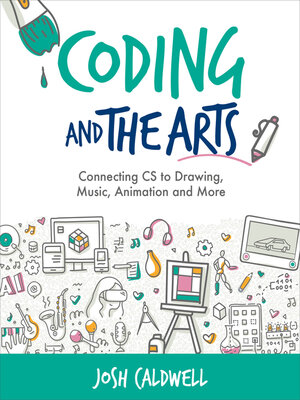Coding and the Arts
ebook ∣ Connecting CS to Drawing, Music, Animation and More · Computational Thinking and Coding in the Curriculum
By Josh Caldwell

Sign up to save your library
With an OverDrive account, you can save your favorite libraries for at-a-glance information about availability. Find out more about OverDrive accounts.
Find this title in Libby, the library reading app by OverDrive.



Search for a digital library with this title
Title found at these libraries:
| Library Name | Distance |
|---|---|
| Loading... |
Unlock your students' creative potential by exploring the intersections between CS and art across various types of artistic media, including drawing, animation, music and physically interactive art.
While there are books that discuss the intersection of the arts and computer science (CS), there are none written for K-12 teachers that cover the content overlaps between CS and the arts beyond a single programming environment, and that feature approaches and examples of practicing artists. Coding and the Arts fills that gap.
CS sometimes gets a bad rap as dry, isolated and uninteresting work — the pursuit of analytically minded techies working alone. In reality, programming is deeply creative and enables artists of all types to discover new ways to express themselves. In this book, you'll explore how to apply computation to stretch the possibilities in many art forms, as well as how to pave the way for entirely new ones. By approaching programming tools as artistic media, you'll connect the dots between programming, creativity and artistic expression. Along the way, you'll learn from a diverse set of computational artists and teachers who are using technology to push the bounds of traditional artistic media.
Chapters include:Spotlights of working artists and educators who are integrating computing into their art. Deep dives into artistic programming environments, exploring their unique benefits, constraints and impact on classroom use. Alignment to the four pillars of computational thinking to help you create richer learning experiences for students. Lesson sketches aligned with CS concepts and the ISTE Computational Thinking Competencies.
The book also offers strategies for supporting students in developing as computational artists, including the attitudes and practices that will help them as artists and computer scientists.
Audience: K-12 educators
While there are books that discuss the intersection of the arts and computer science (CS), there are none written for K-12 teachers that cover the content overlaps between CS and the arts beyond a single programming environment, and that feature approaches and examples of practicing artists. Coding and the Arts fills that gap.
CS sometimes gets a bad rap as dry, isolated and uninteresting work — the pursuit of analytically minded techies working alone. In reality, programming is deeply creative and enables artists of all types to discover new ways to express themselves. In this book, you'll explore how to apply computation to stretch the possibilities in many art forms, as well as how to pave the way for entirely new ones. By approaching programming tools as artistic media, you'll connect the dots between programming, creativity and artistic expression. Along the way, you'll learn from a diverse set of computational artists and teachers who are using technology to push the bounds of traditional artistic media.
Chapters include:
The book also offers strategies for supporting students in developing as computational artists, including the attitudes and practices that will help them as artists and computer scientists.
Audience: K-12 educators







